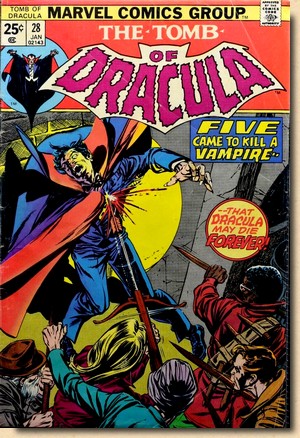|
 |
|
 SPOTLIGHT
ON SPOTLIGHT
ON
TOMB
OF DRACULA #7
(MARCH
1973)
|
|
|
|
| |
|
| |
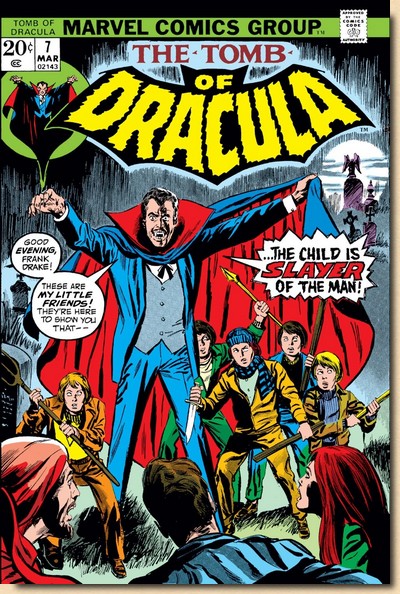
|
|
"Night
of the Death Stalkers!"
(20 pages)
Story
- Marv Wolfman
Art - Gene Colan
Inks - Tom Palmer
Colours - Tom Palmer
Lettering -
John Costanza
Editor - Roy Thomas
Cover pencils - Larry Lieber
Cover inks -
Tom
Palmer
On sale 19
December 1972
published bi-monthly
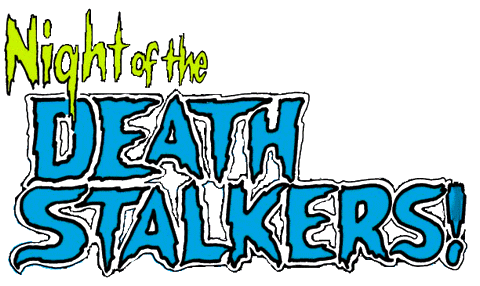
|
|
|
| |
|
| |
| Tomb of
Dracula was Marvel's most popular and
successful horror title of the 1970s, weaving an ongoing
saga that plotted the vampire count against a group of
vampire hunters. It was vividly brought to life by Marv
Wolfman's gripping multi-layer storytelling, Gene Colan's
moody cinematographic artwork, and Tom Palmer's intensely
atmospheric inking. The overall result harked back to the classic
vampire stories but also added new momentum to the theme.
Marvel's Tomb of Dracula was an outstanding
contribution to the genre, a classic in its own right,
and the jewel in the crown of Marvel's Bronze Age horror.
It remains a fan favourite to this day.

|
| |
|
| |
THE
TALE BEGINNETH AFRESH
First talked about
in Marvel's July 1971 Bullpen Bulletin
and
originally planned as a black & white magazine rather
than a colour comic book, Tomb of Dracula #1 was
launched as part of the April 1972 cover date production
run (meaning it actually went on sale on November 16th 1971).
According to Roy
Thomas, Marvel's editor-in-chief at the time, Tomb of
Dracula (the extension to the vampire count's name
was necessary for Marvel to be able to copyright the
title) had a good and solidly selling start (Cooke,
2001), in spite of an initial lack of constant
authorship: youngsters Gerry Conway and Archie Goodwin
worked on issues #1-2 and #3-4 respectively, with veteran
Gardner Fox handling issues #5-6. Whilst they set up the
basic groundwork, the storytelling lacked consistency and
the narrative at times felt hasty.
|
| |
| If the
title was to succeed long term, a stable hand in
penning Tomb of Dracula was required - and
that's exactly what the arrival of Marv Wolfman
for issue #7 was all about. From here on out, the
series would consistently gain traction and
direction under the auspices of the creative team
of writer Marv Wolfman and artist Gene Colan (who
had been on board since issue #1). Wolfman was very much aware of the
challenges he was facing - and had a very clear
idea of how to handle them.
"A
book that was six issues old - with three
different writers (...) I realised pretty
quickly that in order to do anything I had to
decide on the handling of the characters and
what the series was about (...) One of the
things I did was write up pages upon pages of
notes on who the characters were and where I
wanted them to go. I was less concerned about
the individual plots at this point than I was
about the direction of the characters. So I
would write almost up to two years ahead, all
the different turns of the characters and
where they were gonna be, and issue by issue
what would happen with the character. Then I
went back and worried about the stories to
make it work." (Marv Wolfman in
Comic Geek Speak, 2005)
Marvin
"Marv" Wolfman (*1946) had started
working for the comic book industry in 1968 with
DC, yet he was still only 26 when he took over the scripting of Tomb
Of Dracula #7 for the March 1973 cover date
publication schedule.
|
|
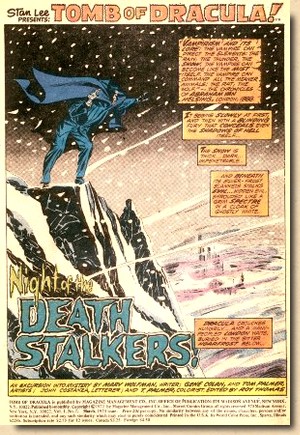 |
|
| |
| There are diverging memories of
who did what in conjunction with Tomb of Dracula
#1 (the October 1971 Bullpen Bulletin credits Stan Lee
with plotting the first issue, whereas Roy Thomas (Cooke,
2001) remembers plotting that issue himself based on just
a few verbal sentences from Lee, whilst Gerry Conway
basically supplied captions and dialogue), but Marvel had
from the outset established a direct link between Bram
Stoker's novel Dracula and the stories told in Tomb
of Dracula, using a number of references to the
literary source through the use of names, locations, and
events. |
| |

Marv
Wolfman in 1975
|
|
This was
also Wolfman's link to the plot and characters he
started to evolve as of Tomb of Dracula
#7.
"I'd never
seen a Dracula movie at that point, but I'd
read the novel, and I loved the novel (...)
Dracula himself was really a force more than
a presence because he's only in 80 or
something pages of a 500 pages novel, so the
attitude of the original book was more on the
people who are hunting him and the effects of
evil on them (...) Using that as the template
for the entire series it seemed to me that
this was an ideal concept to try and do more
realistic comics, to try and break out of the
comics for 11 year olds (...) I really wanted
to try to write something that was starting
to appeal to my age."
(Marv Wolfman in
Siuntres, 2006)
With Wolfman at the
reins (he would continue to write the title for
the remainder of its lengthy run, ending with Tomb
of Dracula #70), Marvel's take on Dracula
became a cleverly conceived and superbly balanced
piece of fiction.
|
|
| |
| |
"THIS
IS REAL - THIS IS NOT JUST A COMIC BOOK"
|
| |
| Unlike Wolfman, Gene Colan (1926-2011), nicknamed both "Gentleman"
and "the Dean" by Stan Lee,
worked on Tomb of Dracula right from the start,
but he too would stay on the book throughout its entire
run - after having literally fought for this assignment
from Stan Lee. |
"The
only strip I really begged for was Dracula.
[Stan Lee] promised it to me, but then he
changed his mind (...) But I didn't take that
for an answer. I worked up a page of Dracula
(...) and I sent it in. I got an immediate
call back. Stan said 'The strip is
yours'." (Gene Colan in
Thomas, 2000)
Colan
created an intensely atmospheric visual rendition
of Wolfman's horror saga and established a look
and feel that went far beyond the classic horror
comic qualities. His style, superbly inked by Tom
Palmer, provided readers with a truly captivating
visual journey into the dark shadows. For Colan,
it all boiled down to a deeply rooted belief that
comic books and movies share common traits.
"I
was mostly influenced by film. Understand
film, frame by frame, is very much like panel
to panel. The lighting in black and white
films taught me a great deal." (Gene Colan in Mata,
2007)
The
cinematic qualities of Colan's artwork also
reflect his view on how he wanted the readers to
perceive and experience his illustrations.
|
|
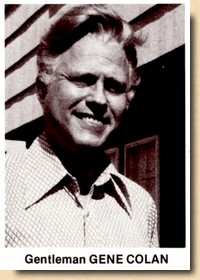
Gene Colan
in 1975
|
|
"Authenticity, for
me, was important, because it made the reader feel
'This is real this is not just a comic book' (...) It
gave the reader the sense that he belonged in the
story and wasn't just reading something (...) I was
into it and wanted the reader to be into it." (Gene Colan in Irving, 2010)
|
| |
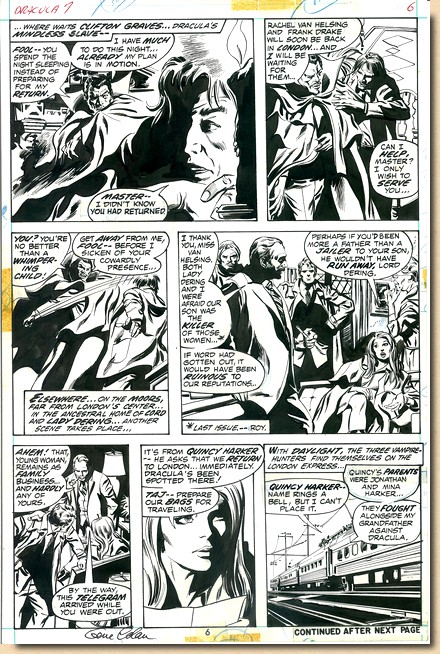 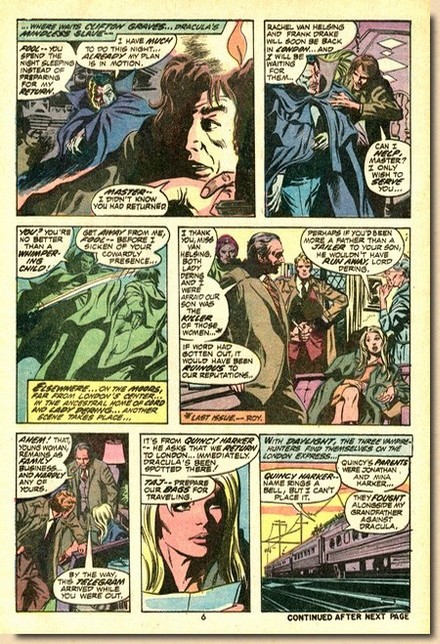
The
first time Quincy Harker's name is mentioned -
Original artwork by Gene Colan (pencils) and Tom
Palmer (inks) for page page 6 of Tomb of
Dracula #7 (scanned from the original)
and the same page as it appeared in print
(colours by Tom Palmer)
|
|
| |
| Both Wolfman and Colan steadily
progressed on the title, from being two enthusiastic
individuals working together to becoming a creative team
where mutual understanding and a shared perception
created results not otherwise possible. The series just
kept getting better and better, and a lot of the classic
material had its seeds in Tomb of Dracula #7. Gene Colan was already in top gear and
clearly in his artistic element, providing gripping
visuals. It all seemingly just flowed from his pencils
with ease as he poured his characters into atmospheric
settings which embodied everything - and more - the genre
had to offer. His cinematographic style and his
enthusiasm for this kind of work left their quality mark
on each and every page, and now, with Wolfman setting out
to give the title and its characters a clear direction,
things were ready to roll.
"The more you work
on something, the better you get at it. I felt that
the character became my own." (Gene Colan in Dlugos, 2002)
"Gene's artwork
certainly is the reason why we could do a lot of that
stuff." (Marv Wolfman in Siuntres, 2006)
|
| |
"DRACULA
IS IN LONDON"
|
| |
| This issue introduces readers
to Quincy Harker, an elderly man in a wheelchair, who (as
Rachel van Helsing explains on the train back to London)
is the son of Jonathan and Mina Harker - both, of course,
pivotal characters in Bram Stoker's novel. |
| |
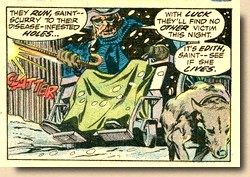
Tomb of
Dracula #7, page 5
|
|
Harker appears very early on in Tomb
of Dracula #7, saving his daughter Edith
from being attacked by Dracula, but in typical
Wolfman fashion we are, for the present moment,
left in the dark as to who this person actually
is. All will however be revealed halfway through
the issue.
With the introduction of
Quincy Harker, Wolfman solidly set Tomb of
Dracula in line with and as a continuation
of Stoker's Dracula. Previosuly, first
steps in this direction had been the introduction
of Frank Drake as a descendant of Dracula, thus
inheriting the count's castle, in Tomb of
Dracula #1, and Rachel van Helsing as
granddaughter of the famous Abraham van Helsing,
in Tomb of Dracula #3 - but neither of
these two characters obviously featured in the
original novel.
Quincy Harker, however,
was an original Bram Stoker character - albeit
spelt "Quincey" and only introduced on
the final page of the novel as a newborn baby.
|
|
"Seven years ago we
all went through the flames (...) It is an added joy
to Mina and to me that our boy's birthday is the same
day as that on which Quincey Morris died. His mother
holds, I know, the secret belief that some of our
brave friend's spirit has passed into him. His bundle
of names links all our little band of men together.
But we call him Quincey.'" (Jonathan Harker's note, in
Bram Stoker, Dracula, chapter 27, final
page)
A very important implication of
this approach for Tomb of Dracula is, of course,
the logical consequence that all main characters of the
novel are just as real as the newly revived Dracula
himself, and events relayed by Bram Stoker actual facts,
not figments of a writer's imagination. This was indeed
the common approach for Marvel and also extended to other
works of fiction, such as Mary Shelley's
Frankenstein.
The moment the band of vampire
hunters meet up with Quincy Harker is taken as an
opportunity by Marv Wolfman to give the connection
between novel and comic book series more depth and
weight, whilst also bringing readers of Tomb of
Dracula who hadn't read the novel up to speed.
|
| |
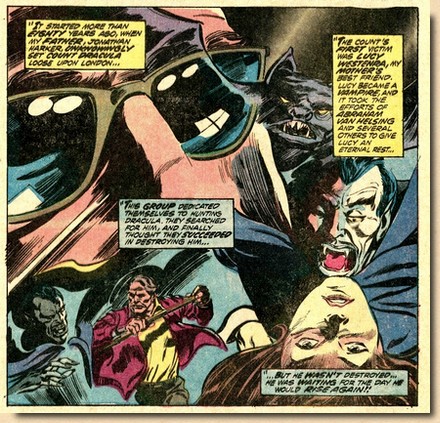 |
|
This is
done across two pages (11 and 12) in the form of
flashback vignettes, and whitout making these
panels too text-heavy, Wolfman gives a very nice
and to the point recap of the novel, and the
atmospheric composition of Colan's artwork is as
cinematic as always, sucking readers into the
fabric of the story. 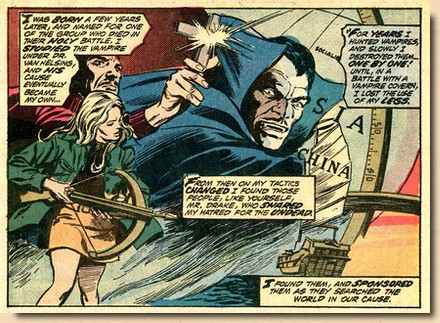
|
|
| |
| Quincy Harker may now be an
elderly man bound to a wheelchair, but he is still in the
business of hunting down vampires (something he has done,
as he himself explains, for the past sixty years after
having been trained by Abraham van Helsing himself), and
indeed he has moved on with the times and now uses
sophisticated technology. Harker clearly is the driving
force behind the group of vampire hunters, carrying on a
lifelong crusade to fight and destroy vampires. |
| |
| For the
remainder of his first issue of Tomb of
Dracula, Wolfman sets up a plot device that
works well and that he will subsequently use
again, in variations, over the next few years:
the purported death of Dracula. In this instance, Dracula
sets a trap for the vampire hunters by luring
them to his hideout, a dark and abandoned house;
the group overpowers the count's minion Cliff
Graves, finds Dracula in his coffin, and drives a
stake into the vampire’s heart - so is the
hunt finally over?
Seasoned comic book readers know, of course,
that a main character of a Marvel title hardly
ever really succumbs to death - and Tomb of Dracula #7 is no
exception.
|
|
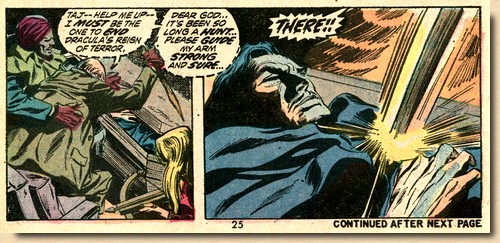 |
|
| |
| It is indeed not the end of Count
Dracula, as the vampire hunters quickly learn as the lord
of vampire's evil laughter fills the room - Quincy Harker
has only staked a lookalike decoy. And worse still, they
now face a group of children ready for the kill under the
mind-control of Dracula... |
| |
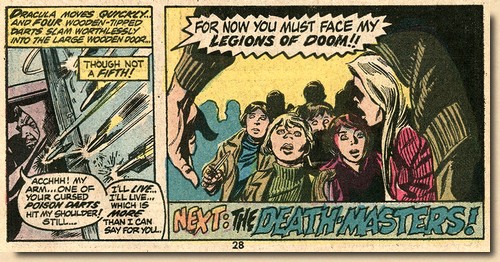 |
|
And so Wolfman's first issue at
the writer's helm of
Tomb
of Dracula ends on a real cliffhanger... to
be continued. One of Wolfman's many
strengths was to weave together plot and
characterization seamlessly, providing an
exhilaratingly interesting storyline that had
readers ask and come back for more. Tomb of Dracula #7
provided a hugely promising start to his tenure -
and those promises would be kept to a large
degree over the entire run of the title.
From this issue on out, the plot
displayed a consistent depth and complexity, with
Wolfman building up
multiple underlying themes and sub-plots in the
overall storyline - some of which would only
reveal their full meaning several issues down the
line.
|
|
| |
 |
|
A
more detailed synopsis of
this issue can be found here. |
|
|
|
|
|
| |
REVIEW & ANALYSIS
|
| |
















